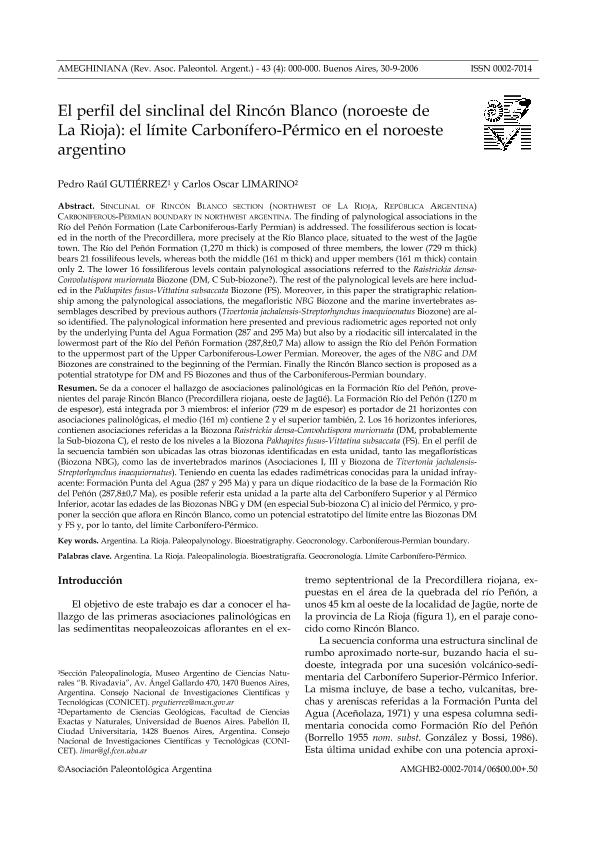Artículo
The finding of palynological associations in the Río del Peñón Formation (Late Carboniferous-Early Permian) is addressed. The fossiliferous section is located in the north of the Precordillera, more precisely at the Río Blanco place, situated to the west of the Jagüe town. The Río del Peñón Formation (1,270 m thick) is composed of three members, the lower (729 m thick) bears 21 fossilifeous levels, whereas both the middle (161 m thick) and upper members (161 m thick) contain only 2. The lower 16 fossiliferous levels contain palynological associations referred to the Raistrickia densaConvolutispora muriornata Biozone (DM, C Sub-biozone?). The rest of the palynological levels are here included in the Pakhapites fusus-Vittatina subsaccata Biozone (FS). Moreover, in this paper the stratigraphic relationship among the palynological associations, the megafloristic NBG Biozone and the marine invertebrates assemblages described by previous authors (Tivertonia jachalensis-Streptorhynchus inaequioenatus Biozone) are also identified. The palynological information here presented and previous radiometric ages reported not only by the underlying Punta del Agua Formation (287 and 295 Ma) but also by a riodacitic sill intercalated in the lowermost part of the Río del Peñón Formation (287,8±0,7 Ma) allow to assign the Río del Peñón Formation to the uppermost part of the Upper Carboniferous-Lower Permian. Moreover, the ages of the NBG and DM Biozones are constrained to the beginning of the Permian. Finally the Rincón Blanco section is proposed as a potential stratotype for DM and FS Biozones and thus of the Carboniferous-Permian boundary. Se da a conocer el hallazgo de asociaciones palinológicas en la Formación Río del Peñón, provenientes del paraje Rincón Blanco (Precordillera riojana, oeste de Jagüé). La Formación Río del Peñón (1270 m de espesor), está integrada por 3 miembros: el inferior (729 m de espesor) es portador de 21 horizontes con asociaciones palinológicas, el medio (161 m) contiene 2 y el superior también, 2. Los 16 horizontes inferiores, contienen asociaciones referidas a la Biozona Raistrickia densa-Convolutispora muriornata (DM, probablemente la Sub-biozona C), el resto de los niveles a la Biozona Pakhapites fusus-Vittatina subsaccata (FS). En el perfil de la secuencia también son ubicadas las otras biozonas identificadas en esta unidad, tanto las megaflorísticas (Biozona NBG), como las de invertebrados marinos (Asociaciones I, III y Biozona de Tivertonia jachalensisStreptorhynchus inaequiornatus). Teniendo en cuenta las edades radimétricas conocidas para la unidad infrayacente: Formación Punta del Agua (287 y 295 Ma) y para un dique riodacítico de la base de la Formación Río del Peñón (287,8±0,7 Ma), es posible referir esta unidad a la parte alta del Carbonífero Superior y al Pérmico Inferior, acotar las edades de las Biozonas NBG y DM (en especial Sub-biozona C) al inicio del Pérmico, y proponer la sección que aflora en Rincón Blanco, como un potencial estratotipo del límite entre las Biozonas DM y FS y, por lo tanto, del límite Carbonífero-Pérmico.
El perfil del sinclinal del Rincón Blanco (noroeste de La Rioja): el límite Carbonífero-Pérmico en el noroeste argentino
Título:
Sinclinal of rincón blanco section (northwest of la rioja, república argentina) carboniferous-permian boundary in northwest argentina
Fecha de publicación:
12/2006
Editorial:
Asociacion Paleontologica Argentina
Revista:
Ameghiniana
ISSN:
0002-7014
e-ISSN:
1851-8044
Idioma:
Español
Tipo de recurso:
Artículo publicado
Clasificación temática:
Resumen
Archivos asociados
Licencia
Identificadores
Colecciones
Articulos(IGEBA)
Articulos de INSTITUTO DE GEOCIENCIAS BASICAS, APLICADAS Y AMBIENTALES DE BS. AS
Articulos de INSTITUTO DE GEOCIENCIAS BASICAS, APLICADAS Y AMBIENTALES DE BS. AS
Citación
Gutierrez, Pedro Raul; Limarino, Carlos Oscar; El perfil del sinclinal del Rincón Blanco (noroeste de La Rioja): el límite Carbonífero-Pérmico en el noroeste argentino; Asociacion Paleontologica Argentina; Ameghiniana; 43; 4; 12-2006; 687-703
Compartir




